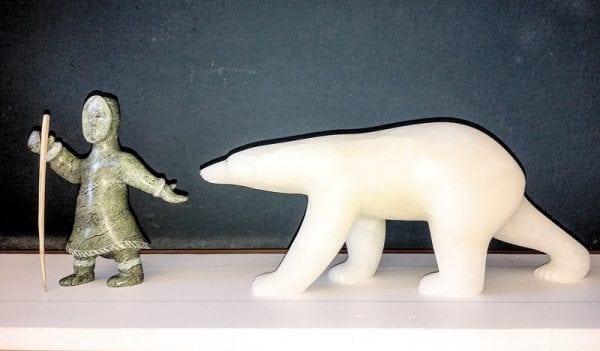Cape Dorset artist Koomuatuk "Kuzy" Curley usually uses power tools.

For a recent carving of an Inuit female elder leading a polar bear – which has been selected to grace the foyer of the soon-to-open Canadian High Arctic Research Centre – he chose to use only chisels, files, sandpaper and patience, so as to highlight principles of Inuit Qaujimajatuqangit.
Though, it's not his exact carving that will be found in the entrance of CHARS, as the piece was created as a maquette, a small-scale model of an unfinished sculpture.
Curley's maquette, which is 30 cm long and made from Baffin Island soapstone and Italian alabaster, will be modelled at approximately six times its size using a strong fibreglass-like material to replicate the textures of the stones.
"This one is the biggest prize in my carving career," said Curley, who found out he was to be granted first place in the competition on April 17. "I didn't expect to win it."
He began working on the elder and polar bear piece in September 2016.
All artwork being integrated into the research station is meant to honour Inuit knowledge. To mirror this theme, Curley depicted a tradition he experienced in his own family.
"I decided to tell a story with the carving," he said.
The work tells the tale of how Inuit would adopt polar bears into their family like children, and how the bears would return often to visit when they were grown.
"...it is not a myth. My grandfather also did this and after the bear grew and left, he would return to the family almost every year," noted Curley in his artist statement for the competition.
Curley's carving skills were passed down to him by his grandfather.
"Elders, like this grandmother, carry on the past knowledge and guide us all, like she guides the powerful bear," he wrote.
Curley was among 13 artists from within Inuit Nunangat invited by Indigenous and Northern Affairs Canada (INAC) to participate in the competition. Three completed pieces were submitted by the project deadline.
Incorporating Inuit art into the centre for Northern science was a priority identified by community members in early concept stages of CHARS, and is intended as a vital part of the design concept, not as an afterthought, said CHARS architect Alain Fournier.
"We're talking about integrating art into the very fabric of the the building," he said.
Fournier was on the jury panel to judge the 3-D art submissions, along with Pam Gross of the Kitikmeot Heritage Society and a representative from INAC.
The art integration process was modelled after a method used in Nunavik to include art in public buildings.
A competition was also held for 2-D drawings, which will be enlarged to as much as 10 metres and used in flooring and interior windows of the centre.
A $1,500 contest honorarium covers copyright use of the carving for the project. Should the centre want to make reproductions or create merchandise, like postcards or magnets, of the piece, the artist will receive additional compensation. The department reserves the right to purchase the original art work and is considering doing that.
Last year, Curley partnered with Pond Inlet artist Ruben Komangapik to create a large granite sculpture that was unveiled at York University on National Aboriginal Day.
Curley is currently living in Woodlawn, Ont. and working on his carving.